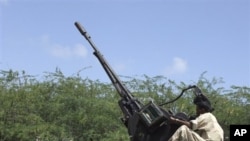Just weeks after a major offensive to eliminate government forces in Mogadishu, a widening rift between key leaders of Somali insurgent group al-Shabab has improved the prospects of survival for the embattled transitional government. The rift has taken pressure off of government and international forces, allowing them to expand their area of control in the war-torn capital.
The Transitional Federal Government of Somalia on Monday announced that government forces, with the help of African Union peacekeepers have managed to take control of areas in Mogadishu previously claimed by al-Qaida linked insurgents al Shabab.
According to a statement issued by the Somali Ministry of Information, the government now controls seven districts within Mogadishu which are home to 90 percent of the city's remaining population. The combined forces took control of a former military hospital as well as areas near the infamous Bakara Market.
The Bakara Market is a labyrinthine neighborhood which is central to business and social life in the capital. The market is controlled by al-Shabab and is frequently used to launch mortar attacks into government positions. The joint United Nations African Union peacekeeping mission, known as AMISOM, has been harshly criticized for killing civilians in the market during retaliatory mortar attacks aimed at al-Shabab.
The government says the fortification of these new positions will reduce civilian casualties experienced in the fighting.
News of the government gains in Mogadishu come on the heels of reports that al-Shabab second-in-command Mukhtar Robow has withdrawn his forces from the capital. The move is apparently related to a long running feud with the group's leader Ahmed Abdi Godane. That rift has been exacerbated by the failed Ramadan offensive, during which al-Shabab forces attempted to drive the government from the city.
An analyst for Brussels-based International Crisis Group, Rashid Abdi, says the recent developments are promising. But, he warned claims of victory over al-Shabab are premature.
"It is a deeply fragmented movement. But the remarkable thing is that despite that fragmentation al-Shabab has continued to be militarily dominant and it currently - as evidenced by the control of the bulk of Mogadishu - shows that the movement still has the military initiative. The government should renew its commitment towards that strategy of beginning to reach out to figures of al-Shabab who may be disenchanted with the hard-line position being taken by Godane and his foreign jihadist allies," he said.
Despite al-Shabab's stated Islamist ambitions, the clan divisions which plague much of Somalia play a significant role in the group's internal politics. According to Rashid Abdi, the three-year struggle between Godane, an Isaaq from the breakaway state of Somaliland, and Robow, a Rahanweyn from southern Somalia, has become a "grudge match" for control of the rebel group.
Nearly one year ago, Godane managed to oust Robow as al-Shabab spokesman. Recently, Godane appointed a member of his Isaaq clan to the position of treasurer, reportedly against the wishes of Robow.
Robow has also opposed the increase in foreign fighters among al-Shabab's ranks. Foreign jihadists from Africa and the Middle East as well as some North Americans have been traveling to Somalia to participate in the insurgency.
Somalia has not had a functioning government since the overthrow of dictator Mohammed Siad Barre in 1991. Al-Shabab is battling the United Nations-backed government to install an Islamic state in the Horn of Africa. The group controls large parts of southern Somalia, including much of the capital.
Somali Government Capitalizes on Internal Divisions in al-Shabab







